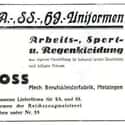-
(#10) Was The SS Uniform Designed By Hugo Boss?
The good news for those with a few of Hugo's ties in the closet: Boss did not design the striking black couture of Himmler's Death's Head cult. Unfortunately, there's more to the story.
The original Hugo Boss opened a clothing factory near Stuttgart in 1924 and supplied the Nazi party from its earliest days with predesigned clothing from templates. Boss supplied similar types of clothing to other organizations, but he also joined the Nazi Party in 1931. Business boomed and Boss advertised his firm as an official supplier of SS Uniforms. Business got even better when Boss received contracts to manufacture military uniforms. During wartime he employed forced labor in deplorable conditions that were ultimately sanctioned in postwar proceedings. Boss died in 1948, but, in 2011, the fashion firm publicly apologized for Boss's Nazi sympathies and ties.
-
(#7) How Did Hermann Goering Obtain A Cyanide Capsule?
Hermann Goering was convicted by the Nuremberg Tribunal and received a capital sentence. Goering requested that he be shot by firing squad but his request was refused. In October 1946, mere hours away from being hanged, he took his own life with a cyanide capsule.
As he was under intense security, it has remained a mystery how Goering managed to get such contraband in his tiny cell. Claims that Goering hid the capsule himself, either on his person or in some part of his cell, seem unlikely based on the frequency and meticulousness of the searches of his cell. Most likely, he had help from some third party who provided the poison at the last minute. One likely candidate is Lt. Jack Wheelis, a guard known to have received an expensive watch, fountain pen, and autographed photos from the manipulative Reichsmarschall. Goering was rumored to have three separate ampules hidden in his luggage and one in a jar of cold cream. It is believed Wheelis probably disingenuously agreed to retrieve the jar for Goering and may have even tipped him off on the exact date of the execution.
In 2005, a US guard named Herbert Lee Stivers came forward claiming to have supplied Goering with the poison. Though historians said the story was "plausible," they admitted we may never know the truth. Regardless of how it happened, Goering's passing proved a major embarrassment for the Allies.
-
(#9) Martin Bormann: Missing For 53 Years
Martin Bormann was Hitler's personal party secretary and, following the German leader's perishing by his own hand, was intent on breaking out of the Bunker and escaping from the Russians. In the confusion of the battle raging in the streets of Berlin, Bormann joined a small group of Nazi dignitaries attempting to evade Soviet patrols. One of these men, Artur Axmann, was separated from Bormann and SS doctor Ludwig Stumpfegger and, after encountering Russian soldiers, ran back in the direction of Bormann. Axmann claims to have definitely seen the bodies of both Bormann and Stumpfegger, but no trace of Bormann or his body ever emerged.
Bormann was convicted in absentia at Nuremberg and received a capital sentence. In 1963, a former postal worker came forward to claim he had helped bury two bodies in 1945, one of which had Stumpfegger's paybook. Nine years later, two skeletons were excavated near the postal worker's alleged burial spot. Their jaws were imbedded with glass, typical of people who have bit down on a cyanide capsule.
West Germany ultimately declared these to be the remains of Bormann (and Stumpfegger), but skepticism remained until DNA technology allowed for conclusive proof in 1998.
-
(#4) Rudolf Hess: Murder Or Suicide?
Initially, Rudolf Hess was Hitler's most important political associate and the stenographer for Mein Kampf, written while both were in prison together. However, his erratic behavior and lack of political sophistication quickly consigned him to the outskirts of Hitler's inner circle. Perhaps to regain credibility, Hess attempted a May 1941 one-man peace mission by flying a twin-seat fighter-bomber over England and parachuting on to the property of the Duke of Hamilton, an individual whom Hess had never even met. He was captured and treated as a POW; Germany disavowed the mission.
After the war, he was convicted at Nuremberg, sentenced to life and placed in the Spandau prison. With the passing or release of all his co-defendants in 1987, Hess was 93 and the only remaining inhabitant of Spandau. On August 17, he was found dangling by a lamp cord; it was pronounced that he had taken his own life. Immediately, controversy surrounded this incident and rumors spread – especially one suggesting that the British, worried that Glasnost in Russia would finally allow for Hess's release and for the embarrassing truth to come out about Britain's actual role in negotiations with Germany, had slain Hess.
An alleged suicide note in his pocket turned out to be from a near-fatal health scare in 1989; also, Hess, at his advanced age, could not have possibly lifted himself off the ground. The uproar precipitated two separate reports by the British government, though both were inconclusive.
-
(#1) Where Did The Amber Room Go?
The Amber Room was an elaborately designed hall in the Soviet Union's Catherine Palace located near St. Petersburg. A gift to Peter the Great from Germany, this unique ornamentation featured amber panels, gold leaf, and mirrors. The rapid advance of the Nazi invasion of 1941 prevented the Russians from removing the panels to safety. They were quickly taken by the Germans and transported to Konigsberg, East Prussia. Initially, the Amber Room was placed on public display at the Konigsberg Castle, but was hidden in anticipation of the 1945 Soviet advance.
While this art masterpiece was never located after the war, most experts believed it was obliterated during the intense shelling that destroyed the Konigsberg Castle. Persistent rumors about the current location of the Amber Room have never panned out.
-
(#6) What Happened To The 'Blutfahne,' The Nazi Ceremonial Relic Flag?
On November 9, 1923, Adolf Hitler led a failed revolt known as the Beer Hall Putsch in Munich. This incident involved an illegal parade and armed confrontation which ended in bloodshed. One of the Nazi participants was carrying an immense swastika flag that fell to the ground and was subsequently covered with the body of a dead Nazi.
The bloodstained flag was retained and presented to Hitler upon his release from prison; it subsequently became a sacred object used to sanctify other Nazi flags at major party rallies. The "Blutfahne" (Blood Flag) even had a special custodian, SS Sturmbannfuhrer Jacob Grimminger, who escorted it during ceremonies. The banner was last seen in public in October of 1944 and then disappeared, its current location unknown.
New Random Displays Display All By Ranking
About This Tool
Our data comes from Ranker, If you want to participate in the ranking of items displayed on this page, please click here.
















